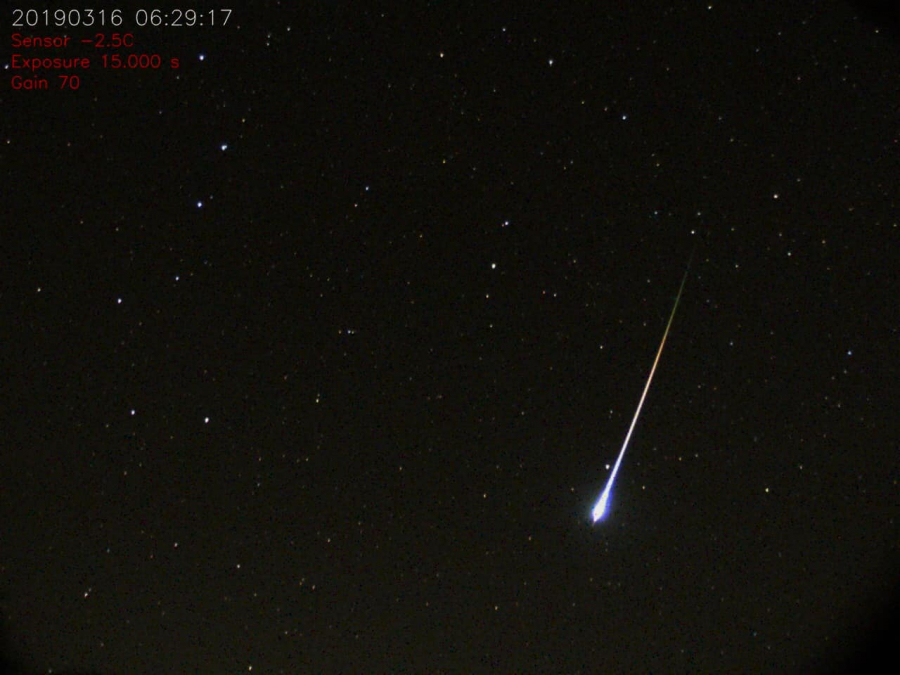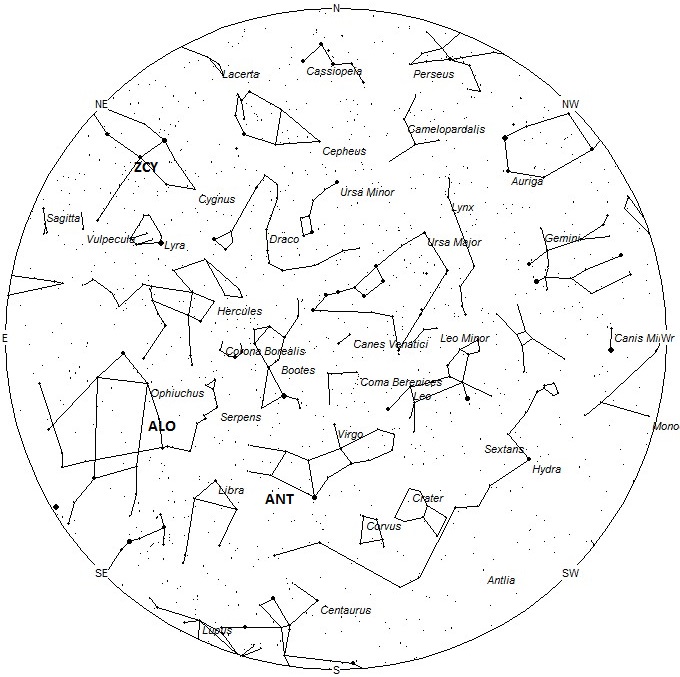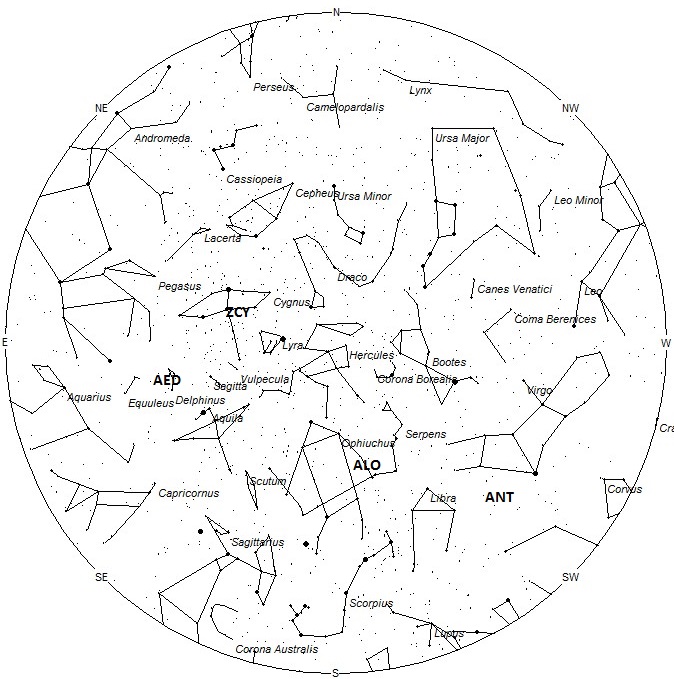 This fireball passes Polaris with Ursa Major also in view. This was recorded by Kevin Palivec from Hawley, Texas on March 16, 2019 at 11:29:17 UT. © Kevin Palivec
This fireball passes Polaris with Ursa Major also in view. This was recorded by Kevin Palivec from Hawley, Texas on March 16, 2019 at 11:29:17 UT. © Kevin PalivecDuring this period the moon will reach its first quarter phase on Friday April 12th. This weekend and for most of the week, the waxing crescent moon will set during the early evening hours and will not interfere with meteor observing as the more active morning hours are free of moonlight. Hourly meteor rates for evening observers this week is near 3 as seen from mid-northern latitudes (45N) and 4 as seen from tropical southern locations (25S). For morning observers the estimated total hourly rates should be near 7 as seen from mid-northern latitudes and 10 from the southern tropics. The actual rates will also depend on factors such as personal light and motion perception, local weather conditions, alertness and experience in watching meteor activity. Note that the hourly rates listed below are estimates as viewed from dark sky sites away from urban light sources. Observers viewing from urban areas will see less activity as only the brighter meteors will be visible from such locations.
The radiant (the area of the sky where meteors appear to shoot from) positions and rates listed below are exact for Saturday night/Sunday morning April 06/07 . These positions do not change greatly day to day so the listed coordinates may be used during this entire period. Most star atlases (available at science stores and planetariums) will provide maps with grid lines of the celestial coordinates so that you may find out exactly where these positions are located in the sky. A planisphere or computer planetarium program is also useful in showing the sky at any time of night on any date of the year. Activity from each radiant is best seen when it is positioned highest in the sky, either due north or south along the meridian, depending on your latitude. It must be remembered that meteor activity is rarely seen at the radiant position. Rather they shoot outwards from the radiant so it is best to center your field of view so that the radiant lies near the edge and not the center. Viewing there will allow you to easily trace the path of each meteor back to the radiant (if it is a shower member) or in another direction if it is a sporadic. Meteor activity is not seen from radiants that are located far below the horizon. The positions below are listed in a west to east manner in order of right ascension (celestial longitude). The positions listed first are located further west therefore are accessible earlier in the night while those listed further down the list rise later in the night.
These sources of meteoric activity are expected to be active this week.
The center of the large Anthelion (ANT) radiant is currently located at 14:00 (210) -13. This position lies in southeastern Virgo, 3 degrees southwest of the 1st magnitude star known as Kang (kappa Virginis). Due to the large size of this radiant, Anthelion activity may also appear from Libra as well as Virgo. This radiant is best placed near 0200 Local Daylight Saving Time (LDT), when it lies on the meridian and is located highest in the sky. Rates at this time should be near 2 per hour no matter your location. With an entry velocity of 30 km/sec., the average Anthelion meteor would be of slow velocity.
The April lambda Ophiuchids (ALO) were first detected by Damir Šegon and the Croatian Meteor Network team based on studying SonotaCo and CMN observations (SonotaCo 2007-2011, CMN 2007-2010). This source is currently listed among the “working ” showers of the International Astronomical Union. A recent article by Masahiro Koseki in WGN (IMO Journal) suggests that this source and other working showers may be strong enough to be observed by visual means. The exact stream duration is not available but this source should be active for a least a week centered on the April 6th maximum. The radiant position at maximum is 16:20 (245) +01. This area of the sky is located southeastern Serpens Caput, 2 degrees southwest of the 4th magnitude star known as Marfik (lambda Ophiuchi). This radiant is best placed near 0500 LDT, when it lies on the meridian and is located highest in the sky. Rates at this time should be near 1 per hour no matter your location. With an entry velocity of 56 km/sec., the average meteor from this source would be of fast velocity.
The last of the zeta Cygnids (ZCY) should be seen through April 10th The expected radiant lies near 20:09 (302) +40. This position is located in central Cygnus, 3 degrees west of the 2th magnitude star known as Sadr (gamma Cygni). This radiant is best placed during the last hour before dawn when it lies highest above the horizon in a dark sky. Rates are expected to be less than 1 per hour no matter your location . With an entry velocity of 40 km/sec., the average meteor from this source would be of medium velocity.
The April epsilon Delphinids (AED) were first identified by P. Jenniskens and R. Rudawska based on studying data from SonotaCo and CAMS observations. Like the April lambda Ophiuchids, this source is also currently listed among the “working ” showers of the International Astronomical Union but may be strong enough to be observed by visual means. The exact stream duration is not available but this source should be active for a least a week centered on the April 13th maximum. The radiant position at maximum is 20:42 (310) +13. This area of the sky is located in central Delphinus, 1 degree southeast of the 4th magnitude star known as Rotanev (beta Delphini). This radiant is best placed during the last hour before dawn when it lies highest above the horizon in a dark sky. Rates at this time should be near 1 per hour no matter your location. With an entry velocity of 41 km/sec., the average meteor from this source would be of medium velocity.
As seen from the mid-northern hemisphere (45N) one would expect to see approximately 5 sporadic meteors per hour during the last hour before dawn as seen from rural observing sites. Evening rates would be near 2 per hour. As seen from the tropical southern latitudes (25S), morning rates would be near 8 per hour as seen from rural observing sites and 3 per hour during the evening hour.
The list below offers the information from above in a condensed form. Rates and positions are exact for Saturday night/Sunday morning except where noted in the shower descriptions.
| SHOWER | DATE OF MAXIMUM ACTIVITY | CELESTIAL POSITION | ENTRY VELOCITY | CULMINATION | HOURLY RATE | CLASS |
| RA (RA in Deg.) DEC | Km/Sec | Local Daylight Saving Time | North-South | |||
| Anthelion (ANT) | – | 14:00 (210) -13 | 30 | 02:00 | 2 – 2 | II |
| April lambda Ophiuchids (ALO) | Apr 06 | 16:20 (245) +01 | 56 | 05:00 | <1 – <1 | IV |
| Zeta Cygnids (ZCY) | Apr 06 | 20:09 (302) +40 | 40 | 09:00 | <1 -<1 | IV |
| April epsilon Delphinids (AED) | Apr 13 | 20:42 (310) +13 | 41 | 10:00 | <1 -<1 | IV |
 American Meteor Society
American Meteor Society



In Niles ohio around 1am. On morning of April 10 me and a friend saw a beautiful shooting star huge looked close red around it super bright long blue tail
I saw from my from porch at work in Cape May the sky light up bright white that it was all white with a Long Red tail , beautifully formed ,totally amazing that’s the way I saw it . Around 11pm 4-16-2019
About 4 of us saw it, April 10, 2019, San Antonio Texas, Sea World Area, 11pm. Out of no where it appeared, moving fast Blue,green,red,white, with glowing tail, then it suddenly blew out! Amazing! Thank you for posting!